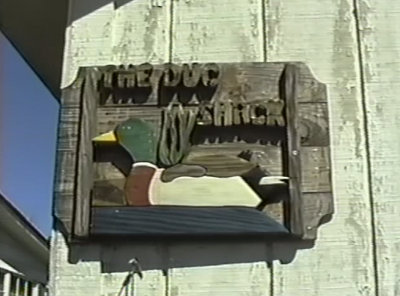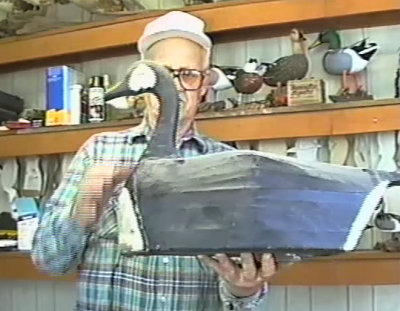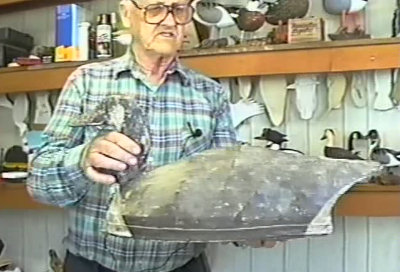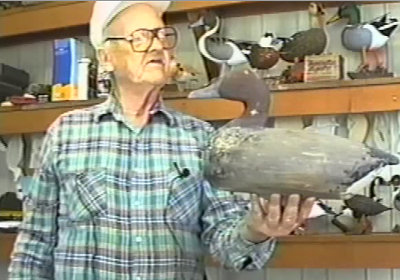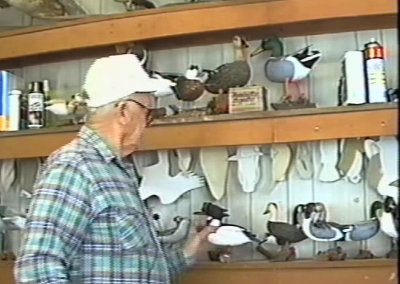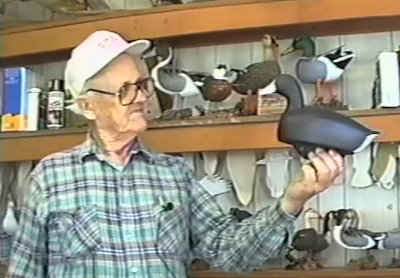Gary: Today we are talking to Roy White who is in his Duck Shack. We will discuss decoy carving and some of the early history of duck carvings.
Roy: I’ve been carving ducks most all my life, off and on. Back in the old days, I made a lot of decoys and then went into the decorative birds. Back in the old days there were several people on Knotts Island (KI) that were duck carvers, making decoys. First off , John Williams up in the north end of KI, Captain John Williams they called him, made battery decoys. Battery decoys were a pretty large duck and they used them on sink boxes out in places like Back Bay and Currituck Sound. In later years, like my daddy, he got into running a Club. He needed decoys and he would make his own decoys mostly. In ’26, ’27 they outlawed the live decoys and pretty near everybody who had the gunning rigs had to make their own decoys because they had no money on KI to buy the decoys. So that’s when they started making the old slat canvas geese and I have one here. I will show you one of ‘em . This is one of them here. (Roy picks up goose) Old slat goose was made in 1927 and is in the Archie Johnson book. Then in later years – that was kinda a heavy bird – later they made the regular canvas geese. (Shows another goose) This is one, made by my brother Edmund White, and was made probably in the ‘40s. (Picks up another) This is one of daddy’s old ducks. My daddy made those back in the 20’s and 30’s. This is a big duck, made especially big for rough water.
Gary: While you are standing there, why don’t you show off some of those in the background?
Roy: And then in the later years, I got into the small stuff (picks up a small carving), more decorative ducks – like this pintail which I’ve been making since 1978. I sell a lot of them in the shows. This is a red-breasted Merganser, old black duck. I make a lot of shore birds. This is a shore bird, old yellow legs, a working decoy, this is a coot, this is what we call a KI Chicken. Most everybody on KI used to eat these things – they were one of the good birds. Then I’m into the shore birds. This is a little sandpiper. I make a yellow leg – they are known all over the country, world, for making my yellow legs. Yellow legs are one of my pride birds. I do a lot of shows - ruddy duck, Canadian Goose. This Canadian Goose – this is number 56 of those geese that I’ve made. Make one for each show that I’m going to now. I do a lot of shows and I’m going to one this week in Chincoteague, Virginia. I do the Mid-Atlantic Wildlife Show, the Currituck show, several shows in this rea, most any show that comes up in this area, little duck shows. Back in the old days, people just made decoys. They didn’t make any of these decorative birds prior to the 50’s, maybe 60’s.
Gary: You mentioned something about a sink box?
Roy: Sink boxes is what they used back in the market days. They put a sink box out in the Sound, with iron ducks on top of it, and then put a hundred ducks around it. And the man would get in the box – in most of the boxes the man would lay down, some were sit down boxes, and lay down boxes and then the ducks would come right to you. That’s the way they killed ducks for the market. My daddy, his first hunting job was with Tully Williams, over in Back Bay. There was nothing for them to kill 500 ducks in one day, to a rig. Tully Williams had five Battery Rigs going. So it was a lot of ducks being killed in those days. But I don’t really think that hurt the duck population because I think what hurt the duck population was just the way they drained the ponds and all up north for their feeding grounds, habitat. But today, our Bay is kinda bad and we don’t have that much duck hunting here like we used to. Back in the 1920’s, 30’s and before that, half of the Island were duck hunters. They were guiding in later years, taking sportsmen out, and in earlier years they were market-hunting. My grandfather, Papa White, met my grandmother, off Churches Island and they both lived on KI and never met each other. One lived in the north end and the other, south end ‘cause that’s the way they did. They would go on the marsh and build themselves a camp. That’s what John Williams did, my grandmother’s daddy, and just all go down there and shoot ducks all week and bring them back that weekend and sell them. That was a way of life in those days – either hunting ducks or fishing. That was the only thing, the only way they had to make money on this Island in those days. We had no way of getting off except by boat, horse and cart. Couldn’t hold any jobs off the Island like they can do now. Now two-thirds of the Island work in Virginia Beach.
Gary: What’s this Battery – you mentioned a Battery duck or rig?
Roy: A rig. They called it a Battery Rig. It was a big old, they used Shad Boats to take their Battery out in or they did. They had a mast on the boat and when they put this Battery out in the water they had a wing onto it that opened up. Two sets of wings. One set went that-a-way. I’ve been into ‘em and the man would get inside the boat and they’d put these iron ducks on the wings to hold ‘em down even with the water. And so that was a way of killing ducks. The ducks couldn’t see you – they’d just see the decoy ducks when he was coming in. So they’d come in – canvasbacks were the main ducks in those days. I’ve heard my daddy say that even those in 1916, 17, 18, 19 and all the way up there they were getting $5 a pair for canvasbacks. It was legal to sell them in those days. And of course the men, the big men , the people who owned the big rigs like Tully Williams they were making a fortune out of ducks ‘cause they weren’t paying them, daddy said, that much. They could sell two or three hundred pairs of canvas backs a week at $5 a pair and had a lot of money.
Gary: So basically you had a Battery Rig and a Sink Rig instead of a Blind?
Roy: The Battery Rig would consist of a Battery and a big Battery Boat which is a Shad Boat – a big old Shad Boat that carried a Battery and carried all the decoys. That would be a Battery Rig. The Sink Box would come off and be put into the water for the man to get into. And then of course the boat had to have a man to wait on that Box. Daddy said that was his first job was waiting on that Sink Box. Then Mr. Tully Williams took him with him and he waited on Mr. Tully Williams. Until one day, Mr. Tully Williams got sick and he put daddy in the Sink Box to shoot, and daddy said that everytime he shot he had to kill at least two ducks. So after that he done the shooting and daddy was one of the best shots that has ever been on this Island I guess, everybody said. I’ve seen him shoot. He would never pull the trigger on a bunch of ducks that he didn’t kill two on the first shot. At least two. But that’s the way he learned to do it in his day. Not me, I’m lucky to kill one out of ten bunches!
Gary: Who were some of the other wood carvers?
Roy: On the Island were several wood carvers. John Litchfield was I believe the biggest carver when I was growing up. He made ducks for Mr. Knapp one time and I used to go up to his house a lot. He had a grandson named Russell Litchfield. I run around with him, played ball with him. Sometimes he’d have a pile of chips, juniper chips where he was making decoys. He made probably two or three hundred for Mr. Knapp over to Mackay Island. But there were several carvers – George Waterfield who made ducks. There are still some of his ducks around. Then we had ‘em on Churches Island – Ned Burgess and some of the Island people would go over there and buy ducks, if they needed ducks. Back in those days, ducks didn’t bring much money. You could buy a nice wood duck, a decoy, for 50 cents at one time. And then they got to a dollar. Lee Dudley too – I think the last bunch Lee Dudley made, he was one of the best known, best known carvers that in later years. The last bunch he made for Elliott Williams he made 20 ducks, Daddy was suppose to deliver ‘em and something come up. He sent me over in a Model A Ford and I carried ‘em up to Elliott Williams and carried back $20 apiece. Now they are worth probably $50,000 apiece. Gary: These are working ducks? Roy: Working decoys. So there has been a big change in the prices of ducks today in what it was when I was a boy. In those days ducks weren’t nothing. In later years I was a guide and if a duck broke loose, we wouldn’t even go pick it up. If the wind was blowing, we’d just let it drift on off. A lot of people like John Barnes told me he had several ducks he picked up ‘cause his blind was down in the leeward. Most of the time the ducks that broke loose, in a north wind, would go on down the Bay and when they come by his blind, he’d pick ‘em up. So he has a lot of ducks now that they picked up.
Gary: Don’t you wish you had kept some of your ducks now?
Roy: See my daddy had a big rig – he had five rigs going at one time. He had about 800 decoys. He had ‘em at his house, some boys got in there smoking one day and he never did know who. The building caught on fire and burnt them up. Most of his decoys that he made and we made got burnt. And another thing was back then when I was a boy before he built the duck house we’d just leave ‘em outside for the year under the old catwood tree and us kids would play. We’d grab one of the strings and weight and take off across the yard and see how fast we could run and that duck would bounce. Of course sometimes you’d knock the heads off. When I got big enough and brother Edmund too, daddy would give us a job to nail some of the heads back on and paint the ducks. Most of these ducks were painted dark brown with a little bit of white onto ‘em, maybe a little spot of green. He’d give us a gallon of brown paint and we’d paint all of ‘em that needed painting. We’d go through them and nail the heads back on and if we couldn’t find the head, we’d stick something back on. We’d make a sleeper duck or something . That’s really how I started carving – duckheads – putting on the ducks. I’d take a piece of wood, a root or anything that looked like a head and I’d sorta make it look like a duck head and put it on there. In fact, in those days, people didn’t worry what the decoys really looked like. They didn’t care. Like Daddy used to say, the duck gets close enough to see what that duck decoy looks like, he gonna shoot him. And that’s probably what happened. Yeah, there’s a big change on KI on the ducks. I don’t know any, John might know – Lee or Lem Dudley, both of these people’s decoys are worth a lot of money today. Lem Dudley had a Club on the Beach, which is a hunting club now. Lee took it over after Lem left in 1970 I understand and most of the ducks he made here were made prior to 1970. Lee kept on making them – he died in 1946 I believe. And the year I delivered those ducks for Elliott Williams was 1939. I wish I had kept ‘em myself, for today.
Gary: To get back to the wood carving today, what basic wood do you use today?
Roy: I use mostly today Tis Wood, ‘tis any kind of wood I can find. My main wood is Tupelo Gum which is white wood, the bottom part of a gum tree, swamp gum that grows in the swamp. But it’s gettin’ so hard to get that sometimes I’m using anything I can buy. This is California Redwood – it’s like our Juniper here. This is Cottonwood. Cottonwood is on the Island, but just can’t get any. But up Chincoteague, it’s their main wood and usually I can get some when I go up there, which will be this weekend. This is Bass Wood. So this is why I say “Tis Wood” because I use any kind of wood I can get. Most all of it works good, except the Tupelo works the best for the wood burning. The wood burning puts the edging on a duck. Before we paint ‘em, we etch, burn all of our ducks - what we call wood burning. On a better bird, we put feathers on them. Big majority of my work is by a knife, just sitting here in this little shack, carving, especially on the heads. I make all the heads with this little pocket knife, little jack knife. Usually I have an old-timers pocket knife in my hand because the knife is what I grew up with. I still like it. Still use it a lot. And this is Tupelo and Tupelo cuts real good, if you’ve got good Tupelo. This is Bass Wood and this is a little bit harder. And then we put the heads on after we get the body made and the head. What we do is drill a little hole into the head, and sit the head onto the duck like we want. Then we tap onto it and it leaves some sawdust behind. Then we next drill into where the sawdust was. Then we use a wooden dowel into the head, and stick the head onto the duck’s body. (Roy twists the head onto the body of the duck.) That’s about the way we put ‘em together. Use a little bit of glue in the wooden dowel and hope they never come apart afterwards. And they usually don’t.
Gary: What about the wings you glue?
Roy: The wings tips are made of craft sticks, little craft sticks. It looks like a popsickle stick. Just round it off at both ends, cut it in two. Cut a slot into the duck and glue it on just like this (Roy shows us how). Just like these two. And put across. I always cross mine to the right. All my ducks I cross, right to the left and that’s about what I do. I’ve been messing around with these ducks, decorative ducks since 1978. I’ve won a lot of ribbons with ‘em, still do. Last show I’ve been to, Atlantic, I put four birds in and won four ribbons. But one of them blue, one a second and two were thirds. But anytime you get a ribbon in competition against a hundred other carvers, we feel like we done pretty good. I don’t make a real fancy duck but I made a duck that, to me, is more like the real duck. I look at the ducks and the shape of ‘em and try to copy the shape of ‘em and decoys. And of the shore birds too. And the painting I do mostly from my book because I can’t remember all the colors. So I just use the books and get the colors. Half the time I’m not right but they look good. And that’s the main thing you’ve got to have – is a good lookin’ duck if you want to sell it.
Gary: And half the people don’t realize what the duck is suppose to look like anyway.
Roy: Yes, the people don’t know what it’s suppose to look like. The more colors we can put on the duck and the brighter the colors, the better we can sell it. Most, the big majority of our ducks, my ducks are the small ducks are sold to the women folks. They buy them for their husbands, sometimes for themselves or as a gift. So decoys I think you might sell a lot more to men than you do the ladies. Little ducks you sell a lot more to the ladies than to the men.
Gary: So what you can do essentially is to look at a picture and get the shape of the duck?
Roy: Yeah, I get the shape of the duck if I’m making a new duck that I’m not used to making then I’m looking at the picture. I have just about all the books they sell from different people that show me the different shapes of the birds, colors, and I have books that tell you colors and how to mix your paint and everything. Like this bird here, it is in the book and it tells you to use black and then white on its breast and gray bill and it will tell you how to paint it the right color. On this bird it is blue (showing bird), and it will say “two parts black, one part white” for the bill which is gray. This mallard, it will tell you to use a raw lumber and a spot of white for his back, and on his sides it gets gray. On his head, of course it is green if it is a male and female we use raw lumber and a spot of white on the whole bird, except the sides of the head.
Gary: Is there a Duck Carvers Guild or organization?
Roy: I belong to most of the Guilds around this area, Currituck and Back Bay. They don’t have a Guild or anything on KI – they should have ‘cuz KI probably has as many carvers for its size as any place in the country.
Gary: Who are some of the carvers?
Roy: Amorese, Joe Flannagan, Romie Waterfield, Ronnie Wade, Victor Wade, Morris Waterman. Morris Waterman is one of the best carvers in the small bird carvers that we’ve ever had on the Island but now he is in the restoring business. He restores the old ducks and he’s good at that-he’s good at anything he tries. His daddy was one of the old carvers too. He tells me he doesn’t remember his daddy making too many old big ducks; I do remember him making big ducks. Also in later years he got into ministry and his name was Sam Waterman and he was a good duck decoy painter. He painted most all the Swan Island ducks during the years I remembered. Benny Ansell used to repaint Reed’s Club which is Fly-A-Way now. In his later years he lived just across the Causeway. Harry Seneca lived just across the Causeway. He made decoys. There are a lot of decoy makers around, but got in the later years there wasn’t much demand for decoys because factories started coming out with their plastic ducks, paper ducks real light. You could put a hundred of those in your boat and it wouldn’t make your boat go down like those wooden decoys would. The wooden decoys become almost obsolete one time and that’s why they got so you could buy ‘em around a dollar apiece, fifty cent apiece in the ‘30s, 40s. You could still buy a decoy, a good decoy duck for a dollar each. Then the Mason come out with a decoy, was a big flat bottom decoy. Before the paper ducks came out that was what took over because they were prettier. Later years, people got so they wanted the pretty ducks out there, ones that would look like a duck. So then they started coming out with those made of paper and plastic. Today they still use plastic ducks.
Gary: So very few ducks made for working ducks now?
Roy: Maybe now and then somebody might buy a duck or swan for decoy but there are just no sales for a duck to actually be used for a decoy. They are usually sitting on the fireplace or sitting around on the floor or on the porches now when you find one. It is just no demand for wood in decoys anymore, to be used as a decoy because they are just too heavy. When a man leaves the shore today he goes out to the blind and he wants to go out there at least 40 mph. He don’t have much time for some reason to get there. Back in the old days, they only have 4 hp motors in our boats and they’d run about 4 knots, 5 miles an hour is all the speed we’d get out of ‘em. And of course it was really good ‘cause we didn’t have all the noise that scares the ducks. Today these outboard motors that within ten miles of him, you can hear and the ducks get up and leave. So they don’t have any place for ducks to rest any more. That’s one reason you don’t have any ducks here any more I think. We have too many motor boats out here. Another reason I think we don’t have any grass in the Bay for the ducks. And the main reason we don’t have any grass in the Bay for the ducks is because of motorboats. We put oil and if you get behind it you can see oily water, so I’m sure that oil and sometimes there is a hundred boats in the Bay. Probably oil is getting to the bottom and smothering the grass out. And of course in the old days we had overwash from the Beach that kinda kept our waters fresh and a little bit brackish. Grass, when I was a little boy, was so thick in the Bay that I could tell where my daddy went to in the morning by the track in the grass. I could just look at the track in the grass that his motor would cut in the grass and know which blind he went to. But there has been a big change in that and now about the only grass we see is the milfold, some celery, but not too much. Gary: Must have been hard for a 4 hp engine to go through that grass? Roy: Well they were, back in those days, motor boats that had weedless wheels in the back, and a skag on the bottom that pressed the grass down so it never made any grass winding on it at all. Today with the motors there is a big wheel that doesn’t have any protection except the bottom of the motor. By the time the bottom of the motor gets to the grass, the wheel catches it, spins it around and winds the grass. In the old skag days about midway of the boat, it came all the way down and it pushes the grass down. You can rig up a skag on an outboard motor. I had one on my boat when I was eeling. I used to eel and fish out here in the Bay all my life just about and after I got an outboard, I put out a piece of metal like two feet in front of the motor and that pushed the grass down inside, and it didn’t wind up too bad. So it’s easy to stop motors from winding grass. Of course high powered boats don’t wind grass so bad anyway, they turn so fast they just cut it back off when it gets on to ‘em. Gary: Now you mentioned eels – was there much eels? Roy: Eeling was one of the main things on the Island and at one time they had 15 or 20 people over here eeling. Making pretty good money – I have made as high as $1000 a week back about 15 years ago in eeling myself. And of course, now, can make more than that probably. In those days I’d be lucky if I got 75 cents/lb for my eels whereas today, they are getting about $3/lb. But the eels aren’t as plentiful now because like I say, there were so many that they were all caught up. But they’re coming back and doing pretty good, like I say, this year. And did pretty good, last year too. And one reason they’re doing good is that today you can get $3/lb and that’s pretty good money. And if you could get 700 to 800 pounds like I used to get you’d be making big money. Gary: So there are still eel fisherman out there? Roy: Yes, there are Wayne Lewark, but I don’t think Joe Lewark eels anymore. Maybe Newman might be eeling so there are probably three or four eeling from the Island right now.
Gary: Is there a season for them?
Roy: No, no season for eels. Just about the only time you can catch these eels is Spring of the year from about now until about May. Then it gets hot and you can’t catch them. They won’t pot. And then in the Fall of the year, they start back in September until it’s cold. Last year I think they were eeling up until about Thanksgiving.
Gary: Do you have special pots for these?
Roy: Yes, special eel pots. Most people use the round pots about 10 inches across and about 30 inches long. Then they have a funnel on each end. There is a tied funnel on one end and a funnel in the middle where there’s a string onto it and a back funnel. The middle funnel has two strings onto it that pulls it together and the back funnel has four strings that holds the hole open. So the eels go in the first funnel and that’s where you put your bait. Then instead of trying to get out, they go into the next one and they can’t find their way back out of there. And then you just pick the pot up, and untie the end and dump the eels. Then tie it back and put the bait into the other end of it and put it back into the water.
Gary: Where are the eels sold?
Roy: New York people, Pennsylvania people come in – they’re getting ‘em but I don’t know exactly who is coming down after them now. I think it’s an outfit out of Baltimore right now. But they’re sold in Japan mostly.
Gary: Really?
Roy: The ship ‘em to Japan. That’s the big market.
Gary: Are they shipped alive?
Roy: Yes, they keep ‘em in the car and and they come down with the live tanks and put ‘em in the tanks and carry ‘em back. I understand they put ‘em in a tank with an agitator on it that keeps the water circulating and ship ‘em over there alive they tell me.
Gary: They’re shipped by air obviously.
Roy: Yeah.
Gary: Must be expensive.
Roy: Yeah.
Gary: Expensive eel when it gets to Japan.
Roy: But I was told they bring $15-$20 a pound over there. So I guess they make money.
Gary: So when you catch them, you put them in some place to keep ‘em alive?
Roy: I keep ‘em alive – in an eel car, what they call an eel car. It’s like a boat only its got a top onto it. And the back end has wire to help the circulation. Two places on the side has wire and most of the eel cars were square on each end and had wire on both ends. Used to have an old boat cut off with wire on both sides and the old boat made it easier to pull that thing up to get to the eels and pull it closer to shore. And that made it easier to pull. And if the eels are thick, then you need something – one car could hold 7 or 800 pounds and I had three cars. Sometimes you had to keep ‘em a week until the man comes. Sometimes I had enough eels myself to fill the man up. Sometimes he’d have to go home and come back for the rest of them.
Gary: Are they dangerous? Do they bite?
Roy: No they don’t bite – just so slippery that you can’t hold on to them. They won’t bite you. No, you can stick your hand right down the barrel. I used to have a barrel in the boat that had an agitator that would keep the water circulating. I could run my hand down there to the bottom and sometime I would to see if the eels were all right at the bottom of the barrel to see if I had too many in there. I never lost but one barrel. I was eeling and lost the cylinder on my outboard motor and I was up to the end of Back Bay and before I could get in (I had too many eels in there) had 800 pounds in that one barrel, about that, and they smothered to death.
Gary: About how long is an eel? Average weight?
Roy: The average ones that we were catching were about ½ a pound to a pound. They get up to 3 or 4 pounds each. You don’t get too many in this Bay that weighs over that much. The Fall of the year when they are leaving out of Back Bay they grow up, what the eel does is lay eggs in fresh water and goes out into the ocean and then grows up and starts coming back in. So when they get back up in this Bay, they grow up pretty big, some of them, then go back out into the ocean. Don’t know what happens then, they never come back no more.
Gary: So what you’re doing is getting the eels that are coming in to lay the eggs?
Roy: Yeah.
Gary: On their way in and on their way out.
Roy: They come in here to grow up, in the Bay. I think they grow up in this fresh water and then go back to the ocean when they get grown.
Gary: Oh, OK.
Roy: I don’t know if they lay eggs up here – I’ve been told all
kinds
of stories about the eels. I’ve been told they lay their eggs in the
ocean and hatch and drift in here on top of the water. Then I’ve been
told they lay their eggs in here and go back to the ocean as little
babies and then come back in here to grow up. I don’t know why they
would do that. I don’t know which way they would do it. Anyway it’s a
pretty good money-making thing here, but today you’ve got to have a big
rig. Back in the old days, when I was a boy, eelers had 50 pots at the
most and then they didn’t use buoys. They used a stick from gum bushes
and just put stake down, and tied the eel pot to the stake.
